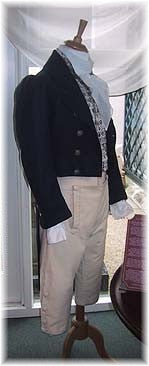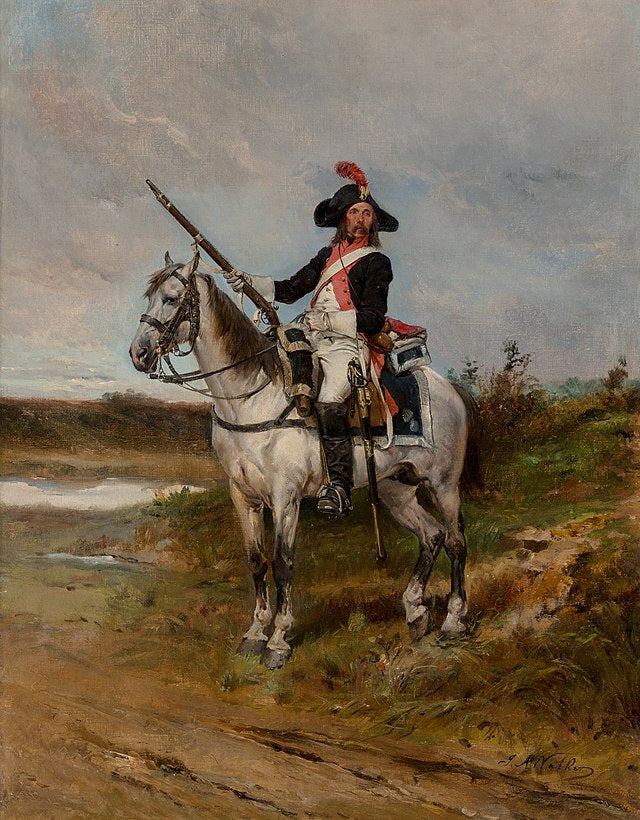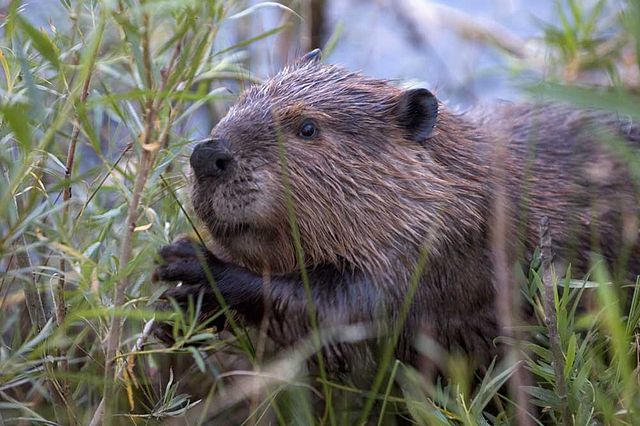Regency Dress for Gentlemen
Towards the end of the 18th Century the tail coat appeared: a style based on the English riding coat. This was made of good wool cloth and gradually became the fashionable garment for men in Europe and America.

The tail coat on display at the Centre is made from 100% English wool doeskin, and is fashioned after a style current about 1810. Notice how few seams there are - just one on each side of the centre back seam. A waist seam to give a better fit to the body was first seen about 1820 and the underarm seam appeared between 1820 and 1830. The tails of the coat at this time finished just above the knee and if you look carefully, you will find that each tail has a pocket concealed in its central seam.
The tailcoat was usually only partially lined and that lining was the same fabric as the body of the garment. The cloth was so tightly woven and heavily milled that most of the edges of the garment were left raw and finished with a row of hand stitching all the way around. Here it is possible to see this detail on close examination. This practice survives in top-quality tailoring with the "hand pricked" finish only on the lapels.
The waistcoat shown here is in a fancy fabric suitable for an evening occasion: for day wear, the fabric would be plainer and of a sober colour - cream, buff, or grey. Only the fronts are in the fancy fabric, the back being made of a plain cotton cloth; a gentleman never removed his coat in company so it would not be seen. The stand collar was very popular for both day and evening. The back is adjusted by means of lacing rather than a buckle.

Breeches were very popular and did not completely fall out of fashion for day wear until about 1825, thereafter still being required for court dress, riding and country wear. The waist is high and the braces were worn to support them. They were often embroidered by the females in the family. The rear of the breeches is quite full to ensure comfort in the saddle, and the waist is adjusted by lacing. The fabric from which the display breeches are made is 100% cotton moleskin.
Following the example of Beau Brummell, a gentleman and his valet would spend a great deal of time and effort in the morning, in search of the perfect arrangement for the cravat- discarding several along the way. Most shirts and cravats were made at home, again, by female relatives. In a letter of January 1799, Jane wrote to Cassandra, "When you come you will have some shirts to make up for Charles [brother]; Mrs. Davies frightened him into buying a piece of Irish [linen] when we were in Basingstoke." The next year she wrote, "I have heard from Charles, & am to send his shirts by half dozens as they are finished. One set will go next week."
Costume researched, designed and constructed by Yvonne Roe, Gloucester. Special to the Jane Austen Centre, Bath.
Find Gentlemen's fashion at our online shop! Click here! The tail coat on display at the Centre is made from 100% English wool doeskin, and is fashioned after a style current about 1810. Notice how few seams there are - just one on each side of the centre back seam. A waist seam to give a better fit to the body was first seen about 1820 and the underarm seam appeared between 1820 and 1830. The tails of the coat at this time finished just above the knee and if you look carefully, you will find that each tail has a pocket concealed in its central seam.
The tailcoat was usually only partially lined and that lining was the same fabric as the body of the garment. The cloth was so tightly woven and heavily milled that most of the edges of the garment were left raw and finished with a row of hand stitching all the way around. Here it is possible to see this detail on close examination. This practice survives in top-quality tailoring with the "hand pricked" finish only on the lapels.
The waistcoat shown here is in a fancy fabric suitable for an evening occasion: for day wear, the fabric would be plainer and of a sober colour - cream, buff, or grey. Only the fronts are in the fancy fabric, the back being made of a plain cotton cloth; a gentleman never removed his coat in company so it would not be seen. The stand collar was very popular for both day and evening. The back is adjusted by means of lacing rather than a buckle.
The tail coat on display at the Centre is made from 100% English wool doeskin, and is fashioned after a style current about 1810. Notice how few seams there are - just one on each side of the centre back seam. A waist seam to give a better fit to the body was first seen about 1820 and the underarm seam appeared between 1820 and 1830. The tails of the coat at this time finished just above the knee and if you look carefully, you will find that each tail has a pocket concealed in its central seam.
The tailcoat was usually only partially lined and that lining was the same fabric as the body of the garment. The cloth was so tightly woven and heavily milled that most of the edges of the garment were left raw and finished with a row of hand stitching all the way around. Here it is possible to see this detail on close examination. This practice survives in top-quality tailoring with the "hand pricked" finish only on the lapels.
The waistcoat shown here is in a fancy fabric suitable for an evening occasion: for day wear, the fabric would be plainer and of a sober colour - cream, buff, or grey. Only the fronts are in the fancy fabric, the back being made of a plain cotton cloth; a gentleman never removed his coat in company so it would not be seen. The stand collar was very popular for both day and evening. The back is adjusted by means of lacing rather than a buckle.
 Breeches were very popular and did not completely fall out of fashion for day wear until about 1825, thereafter still being required for court dress, riding and country wear. The waist is high and the braces were worn to support them. They were often embroidered by the females in the family. The rear of the breeches is quite full to ensure comfort in the saddle, and the waist is adjusted by lacing. The fabric from which the display breeches are made is 100% cotton moleskin.
Following the example of Beau Brummell, a gentleman and his valet would spend a great deal of time and effort in the morning, in search of the perfect arrangement for the cravat- discarding several along the way. Most shirts and cravats were made at home, again, by female relatives. In a letter of January 1799, Jane wrote to Cassandra, "When you come you will have some shirts to make up for Charles [brother]; Mrs. Davies frightened him into buying a piece of Irish [linen] when we were in Basingstoke." The next year she wrote, "I have heard from Charles, & am to send his shirts by half dozens as they are finished. One set will go next week."
Costume researched, designed and constructed by Yvonne Roe, Gloucester. Special to the Jane Austen Centre, Bath.
Find Gentlemen's fashion at our online shop! Click here!
Breeches were very popular and did not completely fall out of fashion for day wear until about 1825, thereafter still being required for court dress, riding and country wear. The waist is high and the braces were worn to support them. They were often embroidered by the females in the family. The rear of the breeches is quite full to ensure comfort in the saddle, and the waist is adjusted by lacing. The fabric from which the display breeches are made is 100% cotton moleskin.
Following the example of Beau Brummell, a gentleman and his valet would spend a great deal of time and effort in the morning, in search of the perfect arrangement for the cravat- discarding several along the way. Most shirts and cravats were made at home, again, by female relatives. In a letter of January 1799, Jane wrote to Cassandra, "When you come you will have some shirts to make up for Charles [brother]; Mrs. Davies frightened him into buying a piece of Irish [linen] when we were in Basingstoke." The next year she wrote, "I have heard from Charles, & am to send his shirts by half dozens as they are finished. One set will go next week."
Costume researched, designed and constructed by Yvonne Roe, Gloucester. Special to the Jane Austen Centre, Bath.
Find Gentlemen's fashion at our online shop! Click here!


Leave a comment
This site is protected by hCaptcha and the hCaptcha Privacy Policy and Terms of Service apply.